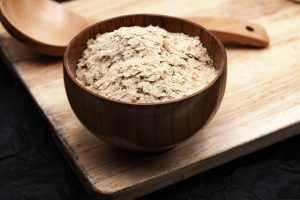
Para-aminobenzoic acid (PABA) sources, health benefits and uses
Tuesday, September 19, 2017 by Frances Bloomfield
http://www.naturalpedia.com/paba-sources-health-benefits-and-uses.html

Para-aminobenzoic acid, also known as 4-aminobenzoic acid or PABA, is an organic compound made by intestinal bacteria synthesizing folic acid. As such, para-aminobenzoic acid was at one point considered to be a part of the B-complex vitamin family while simultaneously being thought of as an amino acid too. Para-aminobenzoic acid can be commercially manufactured and is often added into sunscreen products due to being able to absorb ultraviolet (UV) light. While a non-essential nutrient to humans, there are still some benefits to be gained from para-aminobenzoic acid.
The deficiency of para-aminobenzoic acid is not very common but can occur when intestinal bacteria have sustained damage because of prolonged antibiotic use, and will usually manifest through moist eczema, graying hair, and premature wrinkling. Para-aminobenzoic acid toxicity, on the hand, will include such symptoms as nausea, vomiting, and fever.
The main food sources of para-aminobenzoic acid are brewer’s yeast, molasses, liver, kidney and wheat germ. Mushrooms, spinach, bran, and whole grains like brown rice and whole wheat are good sources of this compound as well. Some vitamin supplements contain para-aminobenzoic acid, while an injectable form is available as well.
Medicinal uses for para-aminobenzoic acid
Para-aminobenzoic acid has been shown to help in the treatment of vitiligo, a skin condition wherein some areas of the skin are devoid of color or pigmentation. Oral para-aminobenzoic acid supplements combined with para-aminobenzoic acid injections were found to be effective in improving the appearance and repigmentation of affected skin areas.
One other skin ailment that para-aminobenzoic acid can assist with is dermatitis herpetiformis, a blistering skin rash often indicative of underlying gluten intolerance or Celiac disease. While para-aminobenzoic acid can’t remedy the disease itself, this compound can reduce the occurrence of skin lesions that come with dermatitis herpetiformis.
Regular intake of para-aminobenzoic acid supplements were noted to have positive effects on women suffering from infertility.
When paired up with vitamin B5, folic acid, and inositol, para-aminobenzoic acid can restore color to hair that has grayed as a result of the deficiency of these vitamins, or because of stress.
Para-aminobenzoic acid plays key roles in red blood cell production, as well as fibrous tissue creation. Moreover, para-aminobenzoic acid has been linked to the prevention or the reversal of accumulated abnormal fibrous tissue, which in turn can lead to fibrous dysplasia — a benign bone tumor — if left unchecked.
While para-aminobenzoic acid is added to sunscreen quite often, these products should be used with caution as some individuals are allergic to sun protection products that make use of para-aminobenzoic acid.
Body systems supported by para-aminobenzoic acid
The skin has the most to gain from para-aminobenzoic acid as it can reduce wrinkles and keep skin smooth and soft. By protecting against UV rays, para-aminobenzoic acid prevents the onset of wrinkles, while nourishing the skin too to help maintain its elasticity and softness.
As a product of intestinal flora, para-aminobenzoic acid can support the digestive system by engaging in various metabolic processes that occur within the gut and play roles in its upkeep.
Since para-aminobenzoic acid has been found to decrease or reverse the accumulation of abnormal fibrous tissue, it can be thought of as good for the bones.
Where to learn more
- Herbs.news
- Nutrients.news
- Prevent Thin Hair and Balding and Grow Hair with Natural Foods
- Protect Your Skin Naturally With Badger Sunscreen (Product Review)
Summary
Para-aminobenzoic acid is a nutrient produced in the gut that is most known for its positive impact on the skin, hair, and digestive system. Para-aminobenzoic acid has been used to alleviate the symptoms of vitiligo, dermatitis herpetiformis, female infertility, and abnormal fibrous tissue.
Sources include:
Tagged Under: Tags: Para-aminobenzoic acid






